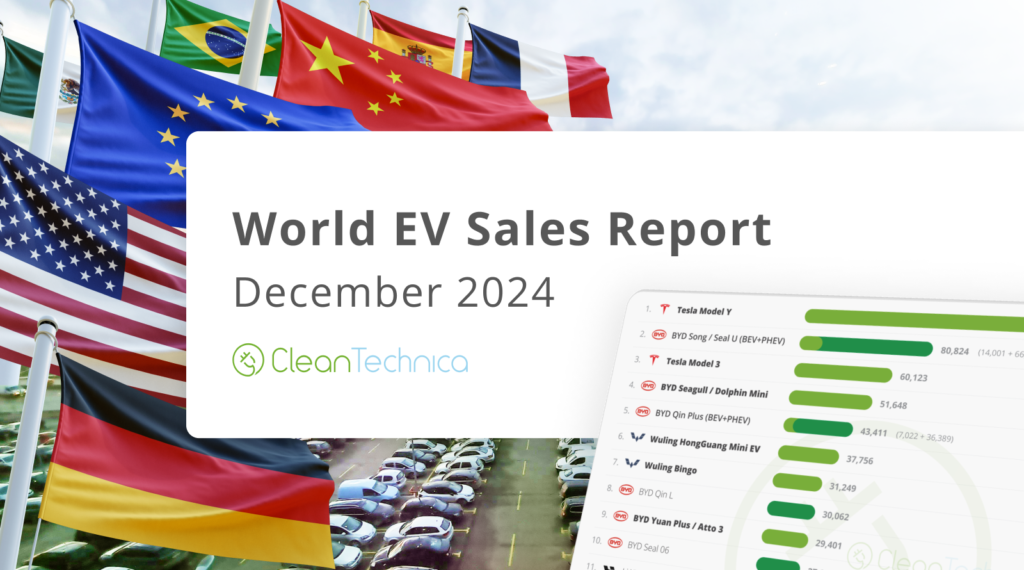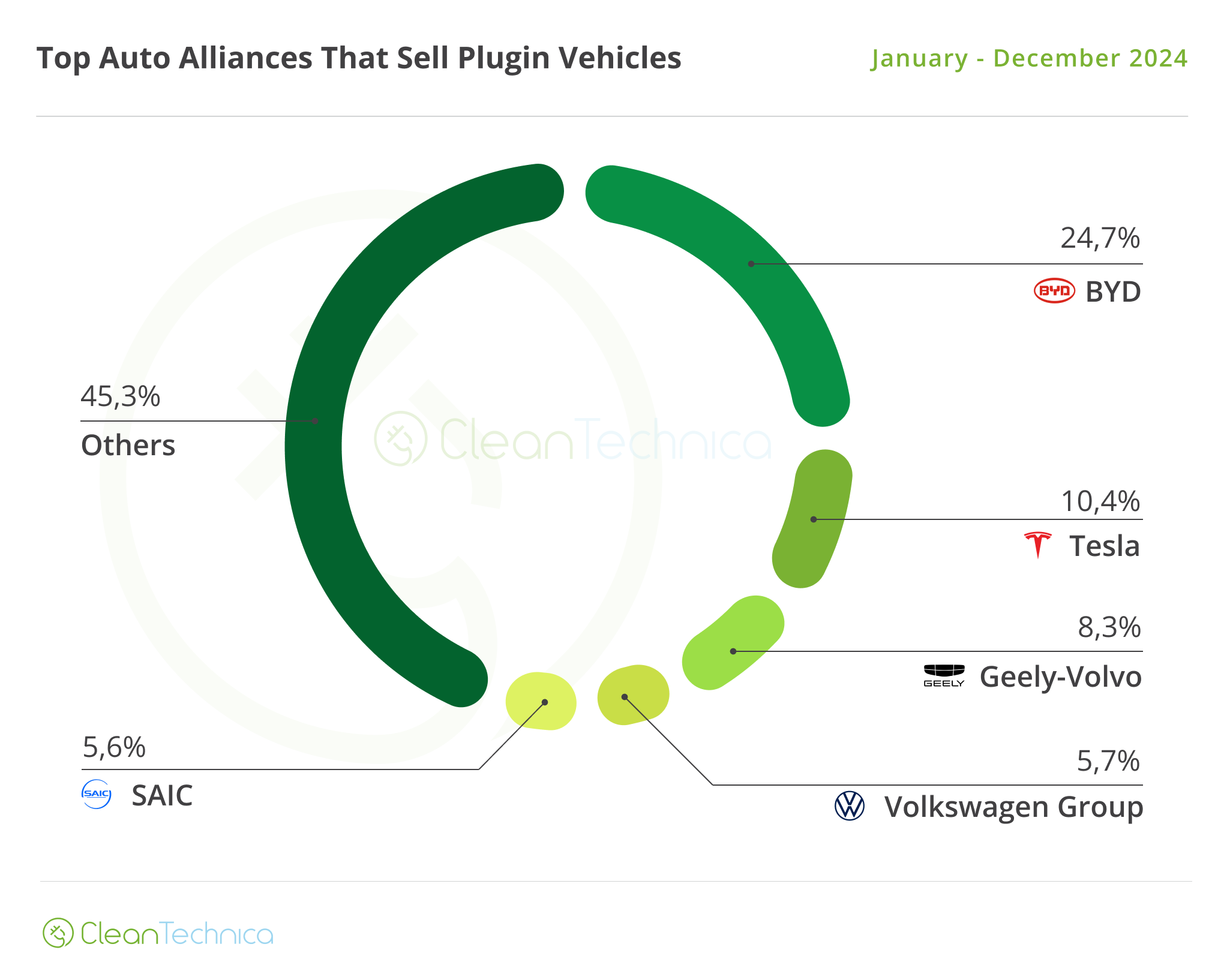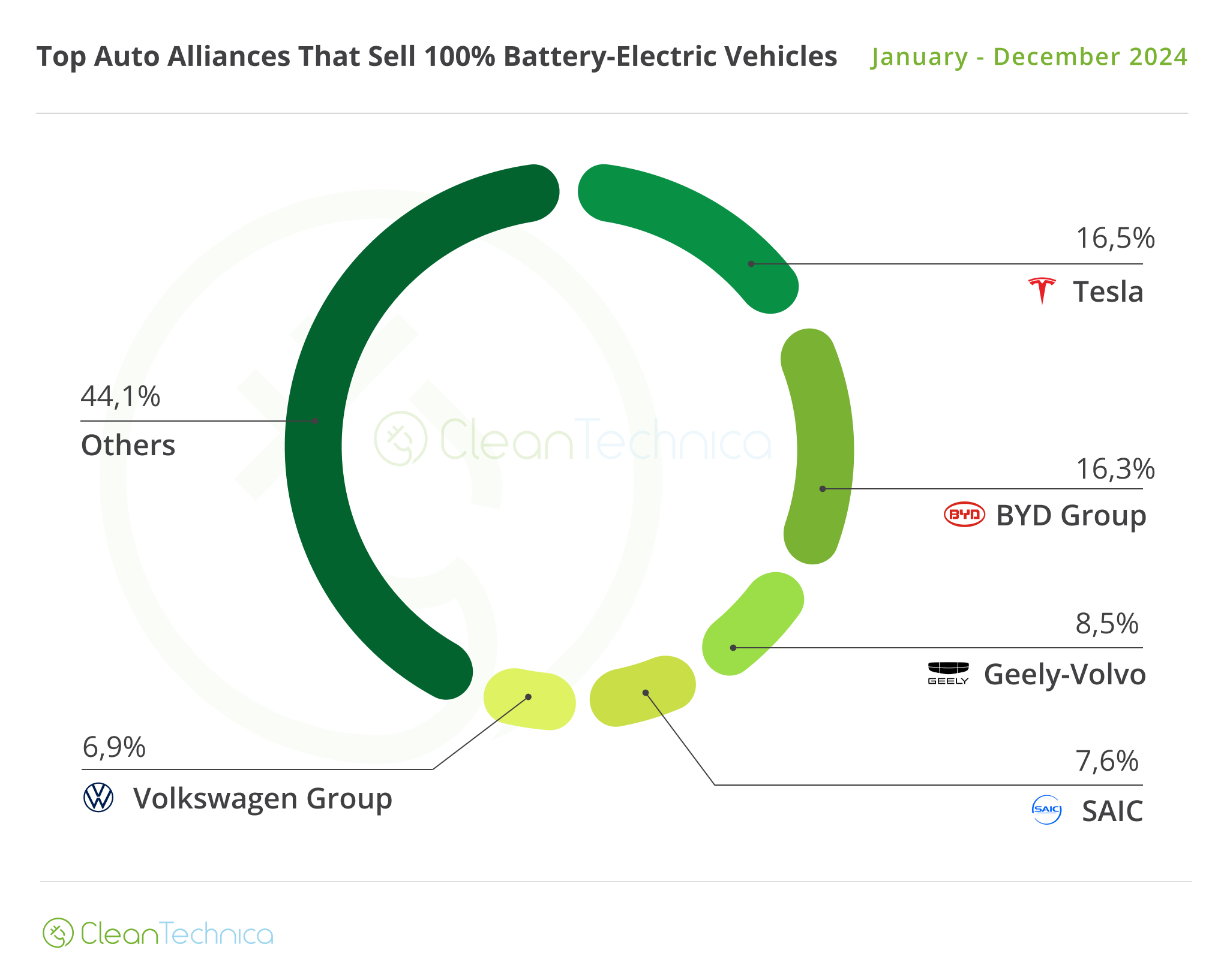
Sign up for daily news updates from CleanTechnica on email. Or follow us on Google News!
Following up on our stories about the best selling plugin vehicles in the world and the automotive brands that sell the most plugin electric vehicles in the world, we’re now closing out the 2024 World EV Sales Report series with a look at the automotive groups or alliances that sell the most plugin electric vehicles and that sell the most pure 100% electric vehicles.
If we gather plugin vehicle sales by automotive group, BYD (24.7% share of the plugin vehicle market) repeated the 2023 title win, with a mammoth 14.3% share (or over 2.4 million unit) advantage over Tesla (10.4%, down from 13.2% share in 2023). BYD gained 0.3 percentage point compared to November, and a significant 2.7% points compared to a year ago.
These trends say that BYD maybe still hasn’t peaked when it comes to market share growth, and with the Shenzhen OEM set to grow by some 30% YoY in 2025, it might well surpass the 25% share barrier in 2025.
As for Tesla, the return to growth is the motto for 2025, so even marginal growth can still be considered as positive — which might mean that the US brand’s EV share will fall below the 10% mark for the first time since 2017.
Trying to catch Tesla, #3 Geely ended the year gaining a bit more share, +0.1% to 8.3%, which is a significant 1.5% gain in market share YoY. And this might place it on orbit to challenge Tesla in 2025. It will depend much on what is going to happen to Tesla in 2025, but after climbing from 4th to 3rd in 2024, I wouldn’t be surprised if Geely once again rose one spot in 2025….
With all the fresh metal coming from the Geely stable next year, which is probably the most prolific in the world, I will even say the Chinese OEM is starting the year as the favorite for the silver medal.
In the B League, Volkswagen Group was 4th, but it lost 0.1% market share in the last month of the year, all while losing 1.6% compared to 2023. Despite this, one can say that the German OEM is without any doubt the leader among legacy OEMs.
Still in the B League, a rising SAIC (5,6%, up from 5.5% in November) came close to displacing Volkswagen Group from the 4th spot. If the year had a 13th month, it might even have surpassed it….
Anyway, Shanghai Auto is benefitting from the current winning streak of Wuling, but it needs to get the remaining lineup of brands helping out in 2025, because winning streaks are not eternal.
In the C-League, while Stellantis (2.7% in 2024, down from 4.2% in ’23) has basically disappeared from the radar (it had been 6th in 2023), the main winner was Changan (3.6% now, up from 2.9% in 2023), which jumped into 6th. BMW Group (3.4% in ’24 vs 4.1% in ’23) retained 7th place (2nd among legacy OEMs) and should be happy to stay somewhere around this position in 2025.
Another winner in this league during 2024 was Hyundai–Kia, which climbed one position to 8th. Although, it has lost significant share, as it ended 2024 with 3.1% share, far from the 3.7% of 2023 or the 4.6% of 2022.
Looking only at BEVs, Tesla again got the title, with 16.5% share of the global BEV market. But this result is a significant loss from the 19.1% share of 2023, and far from the 23% it had at the end of 2020.
The silver medal again went to BYD (16.3%), which interestingly also lost share (-0.2%) compared to 2023! This is explained by the fact that BYD is now betting heavily on PHEVs and leaving BEVs on the bench.
Still, it grew its volumes by almost 200,000 units against a stagnating Tesla, which meant that Tesla won in 2024, yes, but by only 25,000 units, so 2025 will be an interesting race between these two. If BYD is expected to continue growing moderately — say, by growing 15% YoY — that would mean the Chinese OEM would end the year slightly north of 2 million units.
Now, can Tesla reach 2 million units in 2025? Discuss.
Elsewhere, Geely was the OEM that most progressed in the top 5, adding more than 300,000 BEV sales to its tally, to over 900,000 in 2024. That allowed it to jump from 5th in 2023 to 3rd in 2024, winning its first medal and increasing its share from 6.2% to its current 8.5%.
How high will Geely go? Considering its potential on the BEV arena, I wouldn’t be surprised if the Chinese OEM was competing for #1 around 2028 or 2029….
#4 SAIC ended 2024 ahead of Volkswagen Group. It ended the year with 7.6% share, down from 7.9% in 2023. And far from the 9.3% share it had at the end of 2022.
Volkswagen Group (6.9% in 2024, down from 7.8% in 2023) dropped one position compared to 2023, but should stay safe in 5th in 2025, as Chinese OEMs are now turning to PHEVs and EREVs. The remaining legacy OEMs ended 2024 far behind Volkswagen Group (BMW had 4% share in 2024 and Hyundai–Kia 3.8%).
Looking at these results in comparison to the BEV+PHEV tables and charts, it is the same top 5 players. The differences are position changes between BYD and Tesla (with Tesla profiting in the BEV chart from being 100% BEV) and something similar happening to SAIC against Volkswagen Group (as its lineup is much more BEV-based than the fleets of Volkswagen Group).
But, overall, the players in the A, B, & C leagues do not change significantly, with or without PHEVs being included.
My bets for the 2025 top 5 OEMs:
xEV
- BYD
- Geely
- Tesla
- SAIC
- VW Group
BEV
- BYD
- Tesla
- Geely
- SAIC
- VW Group
What are your bets?
Chip in a few dollars a month to help support independent cleantech coverage that helps to accelerate the cleantech revolution!
Have a tip for CleanTechnica? Want to advertise? Want to suggest a guest for our CleanTech Talk podcast? Contact us here.
Sign up for our daily newsletter for 15 new cleantech stories a day. Or sign up for our weekly one if daily is too frequent.
CleanTechnica uses affiliate links. See our policy here.
CleanTechnica’s Comment Policy



